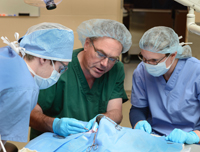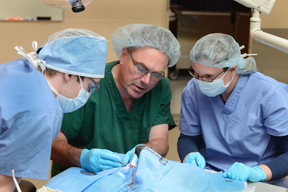Dentistry training may be required in U.S. veterinary schools
!This story has an important update

UCD dental 288

Photo by the UC Davis School of Veterinary Medicine
Learning to extract teeth is an objective of third-year students at the University of California, Davis School of Veterinary Medicine, said Dr. Frank Verstraete, a board-certified veterinary dentist on faculty. Students look on as Verstraete, center, demonstrates extraction techniques on a cadaver head.
Veterinary students soon could get significantly more hands-on training and experience in tooth extractions and periodontal disease should a proposal pass to make dental education a requirement of U.S. accreditation.
Right now, courses on dentistry are electives in most veterinary programs in the country.
That would change if the American Veterinary Medical Association Council on Education adopts a proposal to add dentistry to its accreditation standard on curriculum.
The proposed addition, brought by the COE Academic Affairs Committee, is underlined:
"Instruction in both the theory and practice of medicine and surgery applicable to a broad range of species. The instruction must include principles and hands-on experiences in physical and laboratory diagnostic methods and interpretation (including diagnostic imaging, diagnostic pathology, and necropsy), disease prevention, biosecurity, therapeutic intervention (including surgery and dentistry), and patient management and care (including intensive care, emergency medicine and isolation procedures) involving clinical diseases of individual animals and populations. Instruction should emphasize problem solving that results in making and applying medical judgments."
A public comment period for adding dentistry to the curriculum standard closed July 1. The COE Academic Affairs Committee will analyze and review all comments received and make a recommendation for consideration by the full council during its next meeting, Aug. 30 to Sept. 1.
Rationale for the proposed change reads: "The council believes that dentistry is an integral part of veterinary medical practice and is a crucial component for the health and welfare of multiple animal species. It is essential that students are trained in dentistry."
Feedback generated by the COE's call for comments is not made public; if there's opposition to the change, it hasn't been circulated widely. Online, veterinarians have responded with enthusiastic support. Dr. Elizabeth Clyde of Mattoon, Illinois, is among those who've expressed excitement in response to the AVMA blog post. "This should be included!! I graduated in 1991 with nothing!! Learned to split rooted teeth with wire cutters and pliers!!" she wrote.
One third-year veterinary student said she's received the "bare minimum" in dentistry education, and seasoned veterinarians expressed dismay that many programs still teach very little about dental procedures.
Dr. Tim Kolb in Columbus, Ohio, said he's "baffled" by it. "It seems clear that this is because it is not necessary for accreditation," he wrote in the AVMA blog discussion.
Expert opinion
How accreditation standards evolve
The American Veterinary Medical Association Council on Education is recognized by the U.S. Department of Education as the programmatic accrediting authority for veterinary education.
The COE formed in the 1950s to accredit American veterinary schools and now also extends the distinction to foreign programs. U.S. accreditation confers access to government-backed professional loans.
Comprised of volunteer experts across a variety of disciplines, the COE Academic Affairs Committee periodically audits three or four of the COE's 11 accreditation standards annually and revisits them as a whole every four years to ensure that they continue to meet the needs of the profession, veterinary students and society.
Proposed revisions are considered with input from stakeholders and the public. If adopted, the COE will wait one year before including the revision in its evaluation of programs.
According to COE policy: "While the COE believes some time is necessary to allow colleges to understand and adjust to the new or revised standard(s), rapid implementation is necessary so that colleges can gain experience each year of the curriculum."
Dr. Jan Bellows, a veterinary dentist and consultant for the Veterinary Information Network, an online community for the profession and parent of the VIN News Service, expressed delight with the prospective change. "The AVMA is finally appreciating dentistry and recognizing it as a significant form of practice," he said in a phone interview.
Veterinarians often are expected to provide dental care, whether or not they've been taught dentistry in school, Bellows said.
"This is something that's needed to happen for years and years," he said. "There's nothing like putting the drill in a veterinary student's hand and instructing how to properly extract a tooth. There's no substitute for that kind of experience.
"New veterinarians get out there, and it's dentistry on Day One," he continued. "They might get hundreds of hours on how to take care of a fractured limb, which they'll refer out [to a specialist] anyway. But less than half of them have any formal training on dental surgery beyond a lecture or two. Many don't even touch a dental case before they get out of school."
That's frustrating, Bellows said, and can lead to patient harm including broken jaws. For that reason, he encourages veterinary academia to adopt a "full didactic course" on dentistry for general practice, much like they do for dermatology, ophthalmology and orthopedics.
As one of the first veterinary dentistry specialists in the country, Bellows grew up in the profession when pretty much everyone learned and practiced dental work on the fly. "Like many veterinarians at the time, we cleaned teeth when the mouth smelled a lot, and when teeth were about to fall out, we helped them fall out. We recommended teeth brushing, but no one did it," he said, adding wryly, "We still recommend teeth brushing and practically no one does it."
Bellows' interest in dentistry was piqued one serendipitous weekend in the mid-1980s, when he accepted an invitation from a friend and colleague. Dr. Thomas "Keith" Grove, a veterinarian and human periodontist, wanted Bellows to join him at a dental wet lab in Vero Beach, Florida, where training was conducted on cadavers.
Bellows recounted: "I had a shopping center practice at the time, treating lots of fleas and ticks and skin disease, and I didn't want to go. It was on a Sunday, but my friend talked me into it."
The experience opened his eyes. Back at work, Bellows said, he began to notice that his patients needed a lot of dental care, such as treatment for early periodontal disease, that he previously hadn't embraced or recognized.
To further his understanding, Bellows consulted a human dentist practicing next door, whose business was slow and who shared a love of animals. "He taught me so much about dentistry," Bellows said.
The American Veterinary Dental College formed in 1988. Two years later, Bellows became its 13th diplomate and later served as its president. Today, he's president of the Foundation for Veterinary Dentistry, which supports veterinary dental research, outreach and education. Last year, the foundation donated more than $30,000 to outfit veterinary programs with needed dental equipment.
With some 220 board-certified veterinary dentists in the United States, Bellows suspects that veterinary programs might have a tough time finding faculty. Proper staffing, he said, is key to ensuring veterinary students get enough education to become truly proficient at routine dental procedures.
"Many times, some but not enough education is a disaster waiting to happen," he said. "The harm comes when a veterinarian goes to a wet lab and goes back into practice, gets an animal on the table and hits a bleeding vessel or breaks a jaw," he said. "The whole adage of doing no harm is really applicable in dentistry."
Dentistry at UC Davis
The University of California, Davis School of Veterinary Medicine is among a handful of veterinary schools with a robust veterinary dentistry curriculum.
The program, developed during the mid-1990s by Dr. Frank Verstraete, a board-certified veterinary dentist on faculty, requires first-year students to attend two lectures and complete a two-hour lab in oral anatomy. Third-year students in the small animal track receive 17 lectures and three case discussions, complete four labs involving cadaver heads and 12 hours of instruction on everything from oral radiography and radiology to extraction techniques and rodent dentistry.
By year four, soon-to-be graduates can select a two- to four-week clinical rotation as an elective and can assist residents on clinical cases.
"Dentistry education varies a lot in veterinary academia, but there are schools where they have maybe one or two hours, so we are way ahead of many other programs," he said. "They're nowhere near as comprehensive; we have a full program with didactic teaching, a residency program and research programs."
Running such a program can get expensive, requiring faculty, labs and equipment, Verstraete said. By way of example, he recounted the equipment used for one of his wet labs, which take 24 students at a time: "For that, we have 12 dental units, 12 dental lights, four X-ray machines — and we don't use that equipment for our clinical cases, because of the potential for contamination." The students practice cleanings, extractions and taking radiographs on cadaver heads.
Verstraete said he often hears from practice owners who are impressed that UC Davis graduates are so proficient in dentistry. "Word's gotten out that dentistry is big in Davis," he said, "so they're sometimes asked to develop dentistry in the practices that hire them."
Verstraete, who in addition to running the program helped pioneer a technique to regrow bone for jaw reconstruction, firmly believes that learning the basics in veterinary dentistry is invaluable to those entering small animal general practice.
"Vet schools sometimes are resistant to change, so if you'd go to a school that doesn't have a program and you asked them for four labs and 17 lectures, they might not be enthusiastic," he said. "But dentistry is worth it. It's an essential part of an animal's healthcare and of clinical veterinary practice."
Update: U.S. accredited colleges must now include dentistry in their curricula. The Council on Education approved the revision at its virtual fall meeting, Aug. 30-Sept. 1.